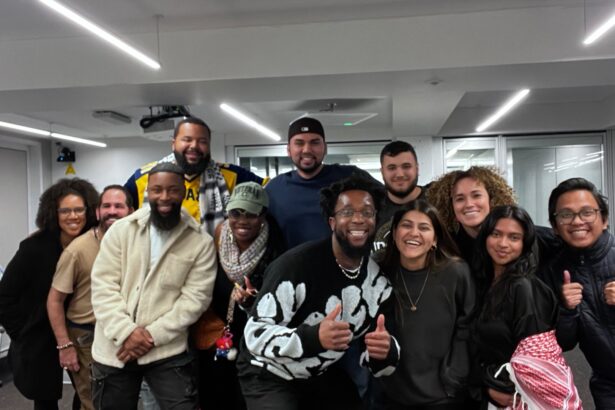Christine Hwang, Devina Neema
A Jeopardy Style Card Game for Teens That Boosts Communication & Collaboration Skills Through Fun, Engaging & Interactive Prompts.
OUR WHYS
DEVINA’S WHY:
During my time as a classroom teacher in an under-resourced public school in India, I witnessed firsthand how social-emotional learning (SEL) could transform students’ interactions, helping them develop better relationships and communication skills. This experience inspired me to create a fun, engaging card game aimed at helping teens build positive relationships through meaningful, collaborative conversations. I wanted to design something that would not only encourage social-emotional development but also be enjoyable for students, making these important skills feel more accessible.
CHRISTINE’S WHY:
As a teacher in a Baltimore City High School, I observed that many students struggled to collaborate meaningfully and faced emotional barriers that affected their engagement in the classroom. A common area students mentioned they wanted to work on was “responsible decision making.” SEL skills, while crucial at this stage of development, are often not explicitly taught in secondary schools, especially in low-resources settings. This gap motivated me to explore a game that focuses on helping teens build these skills in a way that feels fun and interactive.
In today’s world, teens are more accustomed to connecting over their phones than through face-to-face interactions. Communication, collaboration, and problem-solving skills are not always prioritised in traditional classroom settings, yet they are essential for building healthy relationships, emotional intelligence, and skill sets needed for the workplace.
To address this, we designed a Jeopardy-style card game that offers a fun, reflective way for teens to practice and develop communication and collaboration skills in a classroom setting. Our game is based on real-life scenarios and prompts informed by teen voices, providing an opportunity for students to engage with content relevant to their own lives. The game is quick, engaging, and easy to play, designed to encourage teens to connect with one another and discuss issues they commonly face in school, family, and social settings.
GAME PLAY
Card Setup:Cards are arranged in a Jeopardy-style layout (can be randomly selected from a larger deck).
Rows indicate levels of difficulty (Easy to Hard): Reflection, Role-Play, and Scenario.
Columns represent categories: You, Family, Friends, School, World.
Players can choose to play individually (for a more competitive game) or in teams (for a more collaborative experience).
Players take turns drawing cards and completing prompts or tasks.
Each card includes a level-specific rubric and guiding prompt to structure the response.
Scoring:Level 1 cards = 10 points
Level 2 cards = 20 points
Level 3 cards = 30 points
The facilitator awards points based on provided rubrics.
The facilitator rotates after each round.
Goal: Each player must share an appreciation remark with at least one other player. The player with the highest score wins.
GAME DESIGN REFLECTION
IDEATION:
Our initial design process focused on identifying key skills such as communication, empathy, and collaboration. We were inspired by the structure of existing games that promote reflection and learning, while also drawing from our experiences as educators. This helped us craft prompts and game mechanics that felt relevant to the students we hoped to engage.
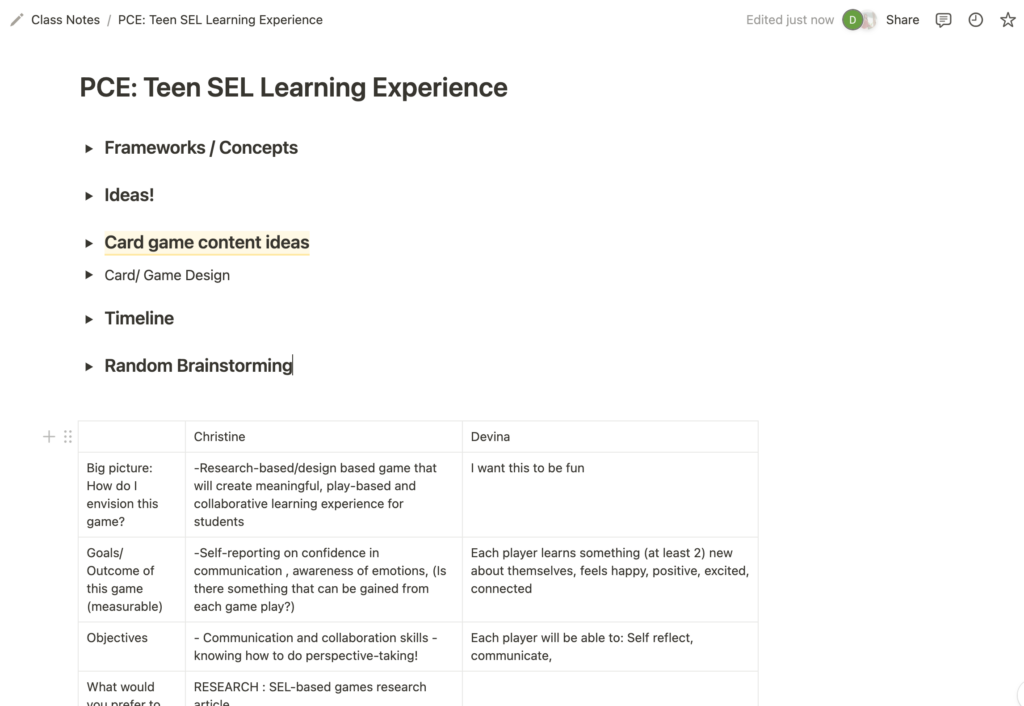
GAME PLAY
Card Setup:Cards are arranged in a Jeopardy-style layout (can be randomly selected from a larger deck).
Rows indicate levels of difficulty (Easy to Hard): Reflection, Role-Play, and Scenario.
Columns represent categories: You, Family, Friends, School, World.
Players can choose to play individually (for a more competitive game) or in teams (for a more collaborative experience).
Players take turns drawing cards and completing prompts or tasks.
Each card includes a level-specific rubric and guiding prompt to structure the response.
Scoring:Level 1 cards = 10 points
Level 2 cards = 20 points
Level 3 cards = 30 points
The facilitator awards points based on provided rubrics.
The facilitator rotates after each round.
Goal: Each player must share an appreciation remark with at least one other player. The player with the highest score wins.
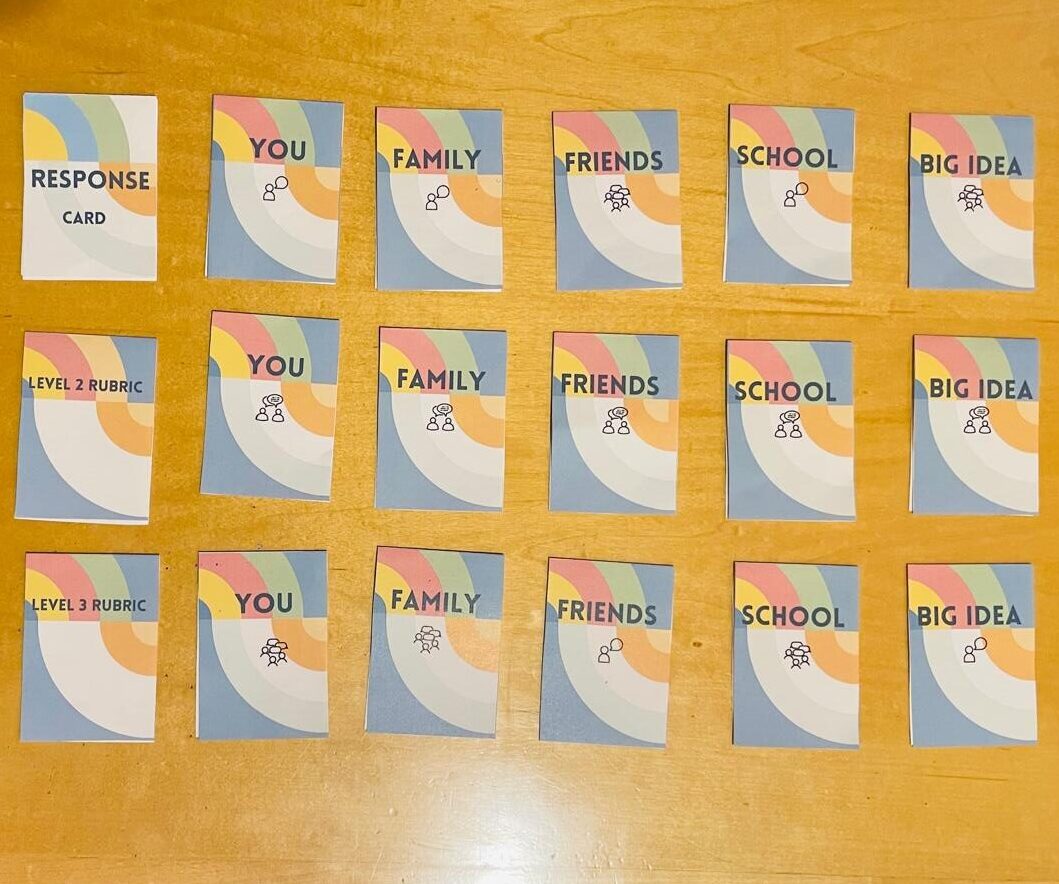
TEEN SURVEY FEEDBACK: We surveyed 35 teens in a high school in Baltimore, gathering feedback that clarified which topics were most relevant to their lives, such as issues related to school, family, and jobs. This helped us refine the prompts for our second iteration, ensuring the content was more aligned with the real challenges teens face.
PLAY TEST #1: In our first play test, players earned tokens based on group consensus. While the prompts were engaging, we noticed that the competitive goal of earning tokens seemed to conflict with the collaborative nature of the game. This feedback was critical, leading us to rethink the reward system to better align with the game’s focus on teamwork and cooperation.

PLAY TEST #2: In the second round of play testing, we removed the token system and focused more on refining the prompts. We also sorted the prompts by their level of difficulty to help players feel more comfortable answering them. This change significantly improved the flow of the game and made it easier for players to engage with the material.
COLLABORATION AND ITERATION
One of the most valuable aspects of this project has been working as partners. We constantly bounced ideas off each other, always questioning whether something would work, asking “What happens next?” or “How can we make this more fun?” Our collaborative approach allowed us to balance fun and engagement with the educational goals we had for the game. Christine focused on creating scaffolded learning for specific skills,, while Devina prioritised making the game enjoyable, so we constantly had a balanced set of ideas to explore.
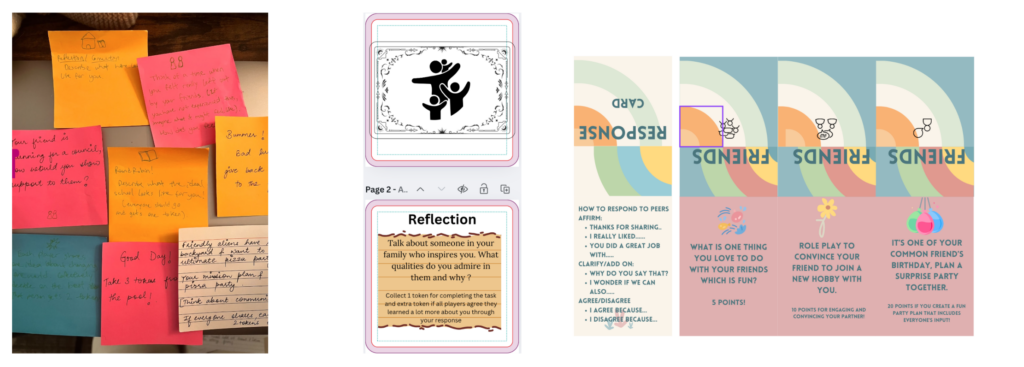
KEY LEARNINGS
Through this process, we learned the importance of iteration and what can be a messy, non-linear journey of design. In line with what we learned in the course, designing for learning is an evolving process, and our game will continue to improve as we test it more. We both realised that learning design is not about creating something perfect from the start, but about continuously refining and improving based on feedback.Our play testing sessions were invaluable in refining the game. The process of tinkering with different elements and incorporating feedback helped us identify what worked and what needed further improvement. Working closely as partners showed us the power of effective collaboration. While we sometimes disagreed, we always kept the project’s goals in mind, which led to productive conversations and better solutions. Focusing on teens’ needs and getting their direct input was essential in making the game relevant and engaging for them. Listening to users helped us improve the prompts and game flow to make it more enjoyable and educational.
WHAT’S NEXT
Our game is still evolving, and we plan to continue refining it. We will incorporate more feedback from playtests and surveys to ensure it is as effective as possible in helping teens build essential communication and collaboration skills. We hope that in the future, this game can become a valuable tool in classrooms to promote SEL in a fun and interactive way.

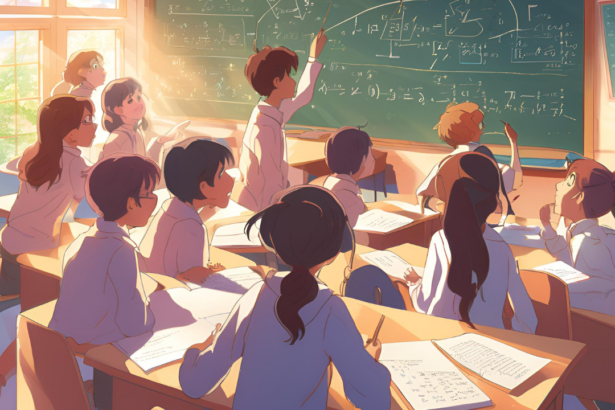
-615x410.png)
